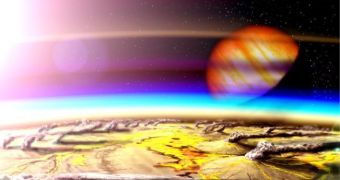In a new investigation, scientists show that detecting volcanic eruptions or related events on exoplanets similar to Earth may now be possible. Such studies could make the quest for alien life a lot easier.
Experts believe that telescope technology is still a long way from becoming capable of observing such eruptions directly. At this point, observatories can barely image large exoplanets as a few blurry pixels.
But chemists say that our current technology is sufficiently developed to allow for scanning the sky in search of sulfur dioxide, which is a substance commonly released during eruptions.
If, during sky surveys, chemical or spectrograph analysis reveals the existence of the substance, then this could mean that scientists finally stumbled upon a planet exhibiting the same type of processes as our own, Space reports.
This would be very important, considering that tectonic activity only occurs on a narrow class of planets. Saturn and Jupiter, as well as other gas giants, cannot exhibit such activity.
It can only appear on a planet with a solid surface, that still has core movement. In our case, the fact that the Earth's core still spins sets magma in motion, which in turn makes continental and oceanic plates slam into each other.
This ongoing process gives birth to volcanism and seismic activity. If traces of volcanism are found on other planets, then we can safely assume that they meet the necessary conditions.
Taking this line of reasoning a bit further, experts believe that places which feature volcanism may represent a perfect place to start in our quest for extraterrestrial life.
“Our first sniffs of volcanoes from an alien Earth might be pretty rank. Seeing a volcanic eruption on an exoplanet will show us similarities or differences among rocky worlds,” says Lisa Kaltenegger.
The expert is based at the Harvard-Smithsonian Center for Astrophysics (CfA), and is also a co-author of the new study detailing the findings.
The new work will appear in an upcoming issue of the esteemed scientific Astrophysical Journal
Some hurdles still remain though. The size of an exoplanetary volcanic eruption will have to be massive, in order to become visible to even the most advanced, space-based observatories.
“You would need something truly Earth-shaking, an eruption that dumped a lot of gases into the atmosphere. Using the James Webb Space Telescope, we could spot an eruption 10 to 100 times the size of Pinatubo for the closest stars,” Kaltenegger believes.
The JWST is scheduled for launch in a couple of years, and it will become the American space agency's main eye-in-the-sky. When deployed, it will be the most advanced, complex and sensitive machine ever built.

 14 DAY TRIAL //
14 DAY TRIAL //